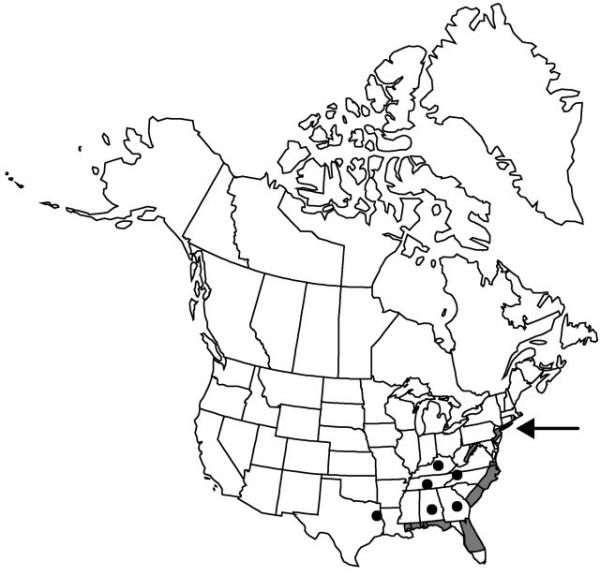Difference between revisions of "Zigadenus densus"
Rhodora 42: 254. 1940.
FNA>Volume Importer |
imported>Volume Importer |
||
| (6 intermediate revisions by 2 users not shown) | |||
| Line 8: | Line 8: | ||
}} | }} | ||
|common_names=Osceola’s plume;black snakeroot;crow poison;pine-barren death camas | |common_names=Osceola’s plume;black snakeroot;crow poison;pine-barren death camas | ||
| − | |basionyms={{Treatment/ID/ | + | |special_status={{Treatment/ID/Special_status |
| + | |code=F | ||
| + | |label=Illustrated | ||
| + | }}{{Treatment/ID/Special_status | ||
| + | |code=E | ||
| + | |label=Endemic | ||
| + | }} | ||
| + | |basionyms={{Treatment/ID/Basionym | ||
|name=Melanthium densum | |name=Melanthium densum | ||
|authority=Desrousseaux | |authority=Desrousseaux | ||
| + | |rank=species | ||
| + | |publication_title=in J. Lamarck et al., Encycl. | ||
| + | |publication_place=4: 26. 1796 | ||
}} | }} | ||
|synonyms={{Treatment/ID/Synonym | |synonyms={{Treatment/ID/Synonym | ||
|name=Amianthium angustifolium | |name=Amianthium angustifolium | ||
|authority=(Michaux) A. Gray | |authority=(Michaux) A. Gray | ||
| − | }}{{Treatment/ID/Synonym | + | |rank=species |
| + | }} {{Treatment/ID/Synonym | ||
|name=Amianthium texanum | |name=Amianthium texanum | ||
|authority=(Bush) R. R. Gates | |authority=(Bush) R. R. Gates | ||
| − | }}{{Treatment/ID/Synonym | + | |rank=species |
| + | }} {{Treatment/ID/Synonym | ||
|name=Helonias angustifolia | |name=Helonias angustifolia | ||
|authority=Michaux | |authority=Michaux | ||
| − | }}{{Treatment/ID/Synonym | + | |rank=species |
| + | }} {{Treatment/ID/Synonym | ||
|name=Oceanoros leimanthoides | |name=Oceanoros leimanthoides | ||
|authority=(A. Gray) Small | |authority=(A. Gray) Small | ||
| − | }}{{Treatment/ID/Synonym | + | |rank=species |
| + | }} {{Treatment/ID/Synonym | ||
|name=Tracyanthus angustifolius | |name=Tracyanthus angustifolius | ||
|authority=(Michaux) Small | |authority=(Michaux) Small | ||
| − | }}{{Treatment/ID/Synonym | + | |rank=species |
| + | }} {{Treatment/ID/Synonym | ||
|name=Tracyanthus angustifolius var. texanus | |name=Tracyanthus angustifolius var. texanus | ||
|authority=Bush | |authority=Bush | ||
| − | }}{{Treatment/ID/Synonym | + | |rank=variety |
| + | }} {{Treatment/ID/Synonym | ||
|name=Tracyanthus texanus | |name=Tracyanthus texanus | ||
|authority=(Michaux) S. Watson | |authority=(Michaux) S. Watson | ||
| − | }}{{Treatment/ID/Synonym | + | |rank=species |
| + | }} {{Treatment/ID/Synonym | ||
|name=Zigadenus angustifolius | |name=Zigadenus angustifolius | ||
|authority=A. Gray | |authority=A. Gray | ||
| − | }}{{Treatment/ID/Synonym | + | |rank=species |
| + | }} {{Treatment/ID/Synonym | ||
|name=Zigadenus leimanthoides | |name=Zigadenus leimanthoides | ||
| − | |authority= | + | |authority= |
| + | |rank=species | ||
}} | }} | ||
|hierarchy=Liliaceae;Zigadenus;Zigadenus densus | |hierarchy=Liliaceae;Zigadenus;Zigadenus densus | ||
| Line 54: | Line 73: | ||
|elevation=0–1800 m | |elevation=0–1800 m | ||
|distribution=Ala.;Del.;Fla.;Ga.;Ky.;La.;Miss.;N.J.;N.Y.;N.C.;S.C.;Tenn.;Tex.;Va.;W.Va. | |distribution=Ala.;Del.;Fla.;Ga.;Ky.;La.;Miss.;N.J.;N.Y.;N.C.;S.C.;Tenn.;Tex.;Va.;W.Va. | ||
| − | |discussion=<p>As treated here, Zigadenus densus includes Z. leimanthoides (W. W. McDearman 1984). These two entities are distinct in some parts of the range, but intergrade in size, inflorescence morphology, and flowering time in the Gulf coast region. The size of the plant (determined by age and environment) seems to affect inflorecence morphology, smaller plants bearing simple racemes and larger plants developing compound ones. Plants in more mountainous habitats develop paniculate inflorescences. Recognition of the two taxa at the varietal level may eventually be desirable.</p> | + | |discussion=<p>As treated here, <i>Zigadenus densus</i> includes Z. leimanthoides (W. W. McDearman 1984). These two entities are distinct in some parts of the range, but intergrade in size, inflorescence morphology, and flowering time in the Gulf coast region. The size of the plant (determined by age and environment) seems to affect inflorecence morphology, smaller plants bearing simple racemes and larger plants developing compound ones. Plants in more mountainous habitats develop paniculate inflorescences. Recognition of the two taxa at the varietal level may eventually be desirable.</p> |
|tables= | |tables= | ||
|references= | |references= | ||
| Line 63: | Line 82: | ||
-->{{#Taxon: | -->{{#Taxon: | ||
name=Zigadenus densus | name=Zigadenus densus | ||
| − | |||
|authority=(Desrousseaux) Fernald | |authority=(Desrousseaux) Fernald | ||
|rank=species | |rank=species | ||
| Line 77: | Line 95: | ||
|publication title=Rhodora | |publication title=Rhodora | ||
|publication year=1940 | |publication year=1940 | ||
| − | |special status= | + | |special status=Illustrated;Endemic |
| − | |source xml=https:// | + | |source xml=https://bitbucket.org/aafc-mbb/fna-data-curation/src/2e0870ddd59836b60bcf96646a41e87ea5a5943a/coarse_grained_fna_xml/V26/V26_75.xml |
|genus=Zigadenus | |genus=Zigadenus | ||
|species=Zigadenus densus | |species=Zigadenus densus | ||
Latest revision as of 21:17, 5 November 2020
Plants 4–20 dm, from bulbs; bulbs not clumped, tunicate, ovoid, 0.5–2 × 1–2 cm. Leaves: proximal blades 10–50 cm × 2–12 mm. Inflorescences racemose or paniculate, 40–100-flowered, cylindrical, 4–15 × 2.5–5 cm. Flowers: perianth hypogynous, 5–10 mm diam.; tepals persistent in fruit, cream colored to greenish, ovate to elliptic, 3–5 mm, narrowed but not sharply contracted basally; gland 1, obscure; pedicel 1–2 cm, bracts often tinged with red, lanceolate, 2–12 mm. Capsules narrowly conic, 10–20 mm.
Phenology: Flowering mid Mar–Jul.
Habitat: Pine bogs, flatlands
Elevation: 0–1800 m
Distribution

Ala., Del., Fla., Ga., Ky., La., Miss., N.J., N.Y., N.C., S.C., Tenn., Tex., Va., W.Va.
Discussion
As treated here, Zigadenus densus includes Z. leimanthoides (W. W. McDearman 1984). These two entities are distinct in some parts of the range, but intergrade in size, inflorescence morphology, and flowering time in the Gulf coast region. The size of the plant (determined by age and environment) seems to affect inflorecence morphology, smaller plants bearing simple racemes and larger plants developing compound ones. Plants in more mountainous habitats develop paniculate inflorescences. Recognition of the two taxa at the varietal level may eventually be desirable.
Selected References
None.
